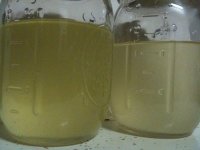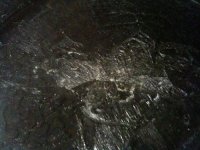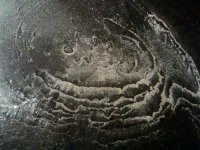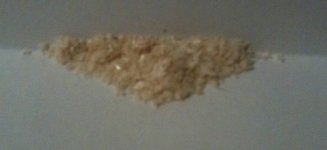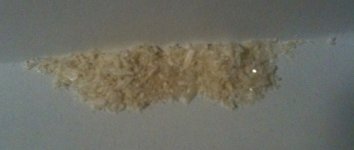So as a community we have been experimenting with ionic strength in plant extractions. I've seen some positive results. People getting larger yields, acacia extracts going more smoothly, etc. Although, I feel like a lot of things are currently being over-looked with regards to this methodology.
I will do this by bullet-point to quantize the information and keep things on a intuitive level rather then overly hypothetical.
Increased yields:
Every extractor loves to see a 3% or a 2% yield especially when 1% will make someone pleased with the results. Real quick what is yield? In the case of a single solvent plant extractions it is whatever solutes migrate to the non-polar phase. IE: Whatever your naptha can pull. So if we are adding salt to an extraction and all of a sudden we are surpassing the 2% yield 'norm'(statistically more likely to be between 1% and 2%), what is the extra stuff? Simply put, the same theoretical reasoning why adding salt to an extraction may also be the reason why more junk would get pulled.
For example if I do an ethanol pull on 50g of plant material and get a 10g yield, that's a 20% yield. Why would I not be so thrilled about this? Largely because 8-9g of it is unwanted goop. Maybe some people prefer more goop for holistic or personal preference reasons, however it isn't really correct to compare goop yield to crystalline yield. I won't get into a purity discussion here though, because even if it's crystalline doesn't mean its impure, same goes for oils, etc.
Simple liquid-liquid extraction theory essentially says that many small volume extractions is better than one large one of the same total volume. Which is an important thing and used in every 'tek' I've seen. This relies on the solubility of the solute in the non-polar solvent and the solubility in water(in this case). As said before, DMT is not very soluble in water, and is most certainly soluble in many non-polar solvents. However, extractions are typically modeled as an 'exponential' function and the difference between pull #4 and pull #5 from a 0.1g digital scale's perspective is usually quiet small. Let alone pull #5 and pull #6. Essentially there shouldn't be much if any difference between adding salt to an extraction if a proper amount of pulls are done.
Less emulsions:
This is nothing new. People have been adding salt and extra lye to emulsified extractions for a very long time now. Infact most STB's require an amount of lye that is completely unnecessary(hundreds of grams where 10's of grams would suffice). Yes lye increases ionic strength just as much as sodium chloride does.
Increased solubility:
Freebase DMT is largely insoluble in water. It might not seem like it because it is kind of oily under some circumstances and has cohesive attractive forces to glass(sticks to glass). This is how the water crystallization tek works after-all.
Now to be fair, the water in a plant extraction does have other non-polars in it, such as proteins, fats and sugars and things which may slightly increase the solubility of say DMT in it. It is of my opinion that this wouldn't constitute too much of an effect. Maybe it does for acacia but I'm not entirely convinced just yet. In which case likely adding more water would give a similar result to adding more salt by diluting the concentration of the contaminants.
Suggestion:
Freebase DMT may not be very soluble in water however free-base mescaline most certainly is. It would seem to be advantageous to try salt techniques on mescaline extractions. Considerably more so than DMT.
That's just my 2 cents. I figured I'd make a thread to discuss this further as I've seen a lot of people trying to jump on the bandwagon with salt teks.
I will do this by bullet-point to quantize the information and keep things on a intuitive level rather then overly hypothetical.
Increased yields:
Every extractor loves to see a 3% or a 2% yield especially when 1% will make someone pleased with the results. Real quick what is yield? In the case of a single solvent plant extractions it is whatever solutes migrate to the non-polar phase. IE: Whatever your naptha can pull. So if we are adding salt to an extraction and all of a sudden we are surpassing the 2% yield 'norm'(statistically more likely to be between 1% and 2%), what is the extra stuff? Simply put, the same theoretical reasoning why adding salt to an extraction may also be the reason why more junk would get pulled.
For example if I do an ethanol pull on 50g of plant material and get a 10g yield, that's a 20% yield. Why would I not be so thrilled about this? Largely because 8-9g of it is unwanted goop. Maybe some people prefer more goop for holistic or personal preference reasons, however it isn't really correct to compare goop yield to crystalline yield. I won't get into a purity discussion here though, because even if it's crystalline doesn't mean its impure, same goes for oils, etc.
Simple liquid-liquid extraction theory essentially says that many small volume extractions is better than one large one of the same total volume. Which is an important thing and used in every 'tek' I've seen. This relies on the solubility of the solute in the non-polar solvent and the solubility in water(in this case). As said before, DMT is not very soluble in water, and is most certainly soluble in many non-polar solvents. However, extractions are typically modeled as an 'exponential' function and the difference between pull #4 and pull #5 from a 0.1g digital scale's perspective is usually quiet small. Let alone pull #5 and pull #6. Essentially there shouldn't be much if any difference between adding salt to an extraction if a proper amount of pulls are done.
Less emulsions:
This is nothing new. People have been adding salt and extra lye to emulsified extractions for a very long time now. Infact most STB's require an amount of lye that is completely unnecessary(hundreds of grams where 10's of grams would suffice). Yes lye increases ionic strength just as much as sodium chloride does.
Increased solubility:
Freebase DMT is largely insoluble in water. It might not seem like it because it is kind of oily under some circumstances and has cohesive attractive forces to glass(sticks to glass). This is how the water crystallization tek works after-all.
Now to be fair, the water in a plant extraction does have other non-polars in it, such as proteins, fats and sugars and things which may slightly increase the solubility of say DMT in it. It is of my opinion that this wouldn't constitute too much of an effect. Maybe it does for acacia but I'm not entirely convinced just yet. In which case likely adding more water would give a similar result to adding more salt by diluting the concentration of the contaminants.
Suggestion:
Freebase DMT may not be very soluble in water however free-base mescaline most certainly is. It would seem to be advantageous to try salt techniques on mescaline extractions. Considerably more so than DMT.
That's just my 2 cents. I figured I'd make a thread to discuss this further as I've seen a lot of people trying to jump on the bandwagon with salt teks.

